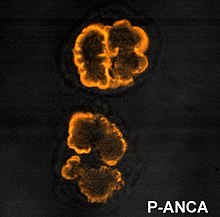Our website is made possible by displaying online advertisements to our visitors.
Please consider supporting us by disabling your ad blocker.
Anti-neutrophil cytoplasmic antibody



Anti-neutrophil cytoplasmic antibodies (ANCAs) are a group of autoantibodies, mainly of the IgG type, against antigens in the cytoplasm of neutrophils (the most common type of white blood cell) and monocytes. They are detected as a blood test in a number of autoimmune disorders, but are particularly associated with systemic vasculitis, so called ANCA-associated vasculitides (AAV).[1]
- ^ Sharma P, Zonozi R, Geetha D (2024). "ANCA-Associated Vasculitis". Advances in Kidney Disease and Health. 31 (3): 194–205. doi:10.1053/j.akdh.2024.04.005. PMID 39004459.
Previous Page Next Page
أجسام مضادة سيتوبلازمية مضادة للعدلات Arabic Anticossos anti antígens citoplasmàtics dels neutròfils Catalan Anti-Neutrophile cytoplasmatische Antikörper German Αντιουδετεροφιλικά αντισώματα Greek Anticuerpos anticitoplasma de neutrófilos Spanish Anticorps anticytoplasme des polynucléaires neutrophiles French Anticorpi anti-citoplasma dei neutrofili Italian 抗好中球細胞質抗体 Japanese Antineutrofiele cytoplasmatische antistoffen Dutch Przeciwciała przeciw cytoplazmie neutrofilów Polish


